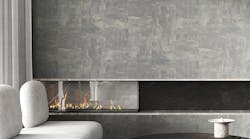From abandoned schools in Cleveland to offices in New York City, designing spaces within fixed floor plans of formerly new facilities is commonplace for commercial interior designers. Adaptive reuse and restoration projects continue to surge in popularity, breathing new life into ageing structures while promoting sustainability.
These projects showcase the remarkable potential to harmonize the old and the new, creating seamless, eye-catching environments. Wallcovering Association manufacturer members understand the importance of materials that offer adaptability for restoration projects. They continue to provide commercial designers with an array of creative choices to blend aesthetics and functionality.
Three key considerations should be noted when it comes to surfaces suitable for wallcoverings in adaptive reuse and restoration. First, wallcoverings are excellent for covering up aged and uneven walls, such as those in older structures. The textured and patterned designs of wallcoverings can conceal imperfections, resulting in a sleek and polished finish. Second, wallcoverings work exceptionally well in transforming plain and uninspiring surfaces into captivating focal points, adding character to otherwise dull spaces. Third, wallcoverings protect historic and architecturally significant walls.
In adaptive reuse and restoration projects, preserving the original structure's integrity and beauty is paramount. By adding a durable layer, wallcoverings help extend the lifespan of the underlying walls. Let’s dive into four examples of wallcovering solutions perfect for your next restoration assignment.
Koroseal
York Contract
The Restoration Elements collection and high-performance vinylwallcoverings from York Contract provide a versatile solution to transform spaces. These wallcoverings expertly mask textural imperfections such as minor cracks and damaged surfaces. Whether mimicking vintage aesthetics or creating a durable, timeless backdrop, these wallcoverings are pivotal in preserving heritage charm in public spaces. Offering the streamlined practicality of industrial design and minimalist décor, the Restoration Elements, including the Hammerstone pattern (style) colorway, delivers an aesthetic committed to preserving and appreciating the work-worn finishes and useful goods of the manufacturing workspace.




